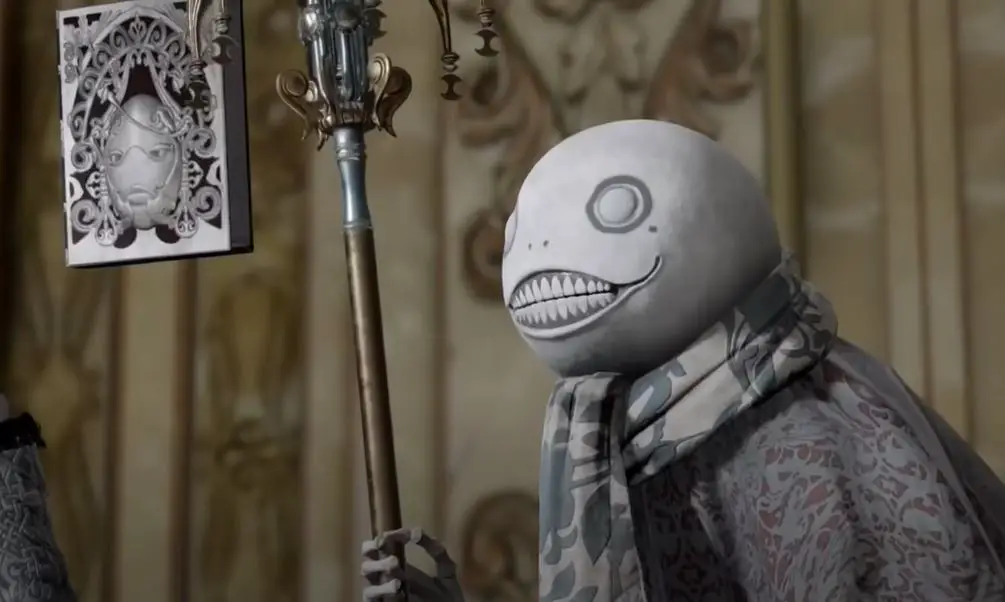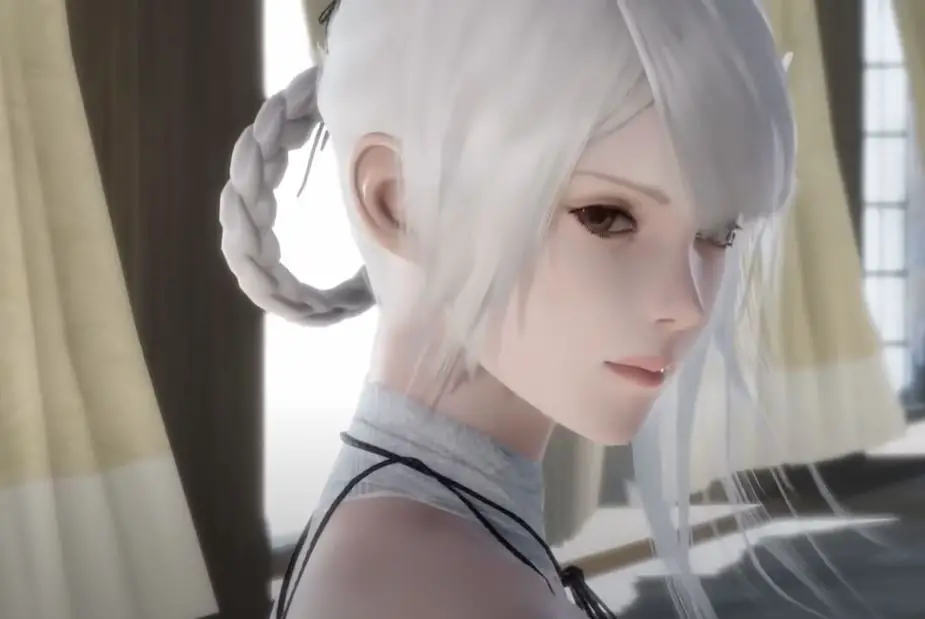I should say this right away; no, I did not play the original Nier on the Playstation 3. I am one of those millions of filthy Yoko Taro casuals who played Nier: Automata and fell in love within an hour. Automata was so good that by the time I played through all is endings, it easily ranked among the greatest games I have ever played and one of the most impactful stories I have ever experienced. Nier: Automata was easily good enough for me to purchase Nier: Replicant on day one. At least, that was after viewing a few gameplay videos to make sure the gameplay would not be the horrid trash many describe the original PS3 release as being.
As such, I did not go into Replicant thinking it would be better than Automata. I adjusted my expectations accordingly. This was a Taro-described “version upgrade” of a PS3 game that was considered dated upon release. I was here for what fans describe as one of the best stories in video game history, one argued as better than Automata’s, and a soundtrack considered that was supposed to be even better.
And really, that is exactly what Nier: Replicant gave me. It is a game with a haunting, impactful, emotionally destructive story centered around a cast of emotionally destructive characters, with an absurdly great soundtrack. Around that is a game that, despite having a theoretically fun combat system, is wrapped up in level and quest design that would have been dated in 2010 when the game released, let alone now.

Replicant is one of the best examples I can think of a product that truly tests the power of a good story to pull you through a video game. At the same time, it is also one of the best examples of a game that tests just how much misery you can push on a player before it loses impact.
Even going in knowing the game would feel dated, I was still surprised about just how ancient so many elements of the game feel. Replicant often feels like a prototype Automata, and other times like a game that was late to the open world craze and did not have the budget to create a good one. You leave from the same hub to run across the same three fields to the same handful of destinations to complete the same kinds of quests over and over.
Even worse, many of these quests require resource grinding or busting up either trash mobs or the same two or three big minibosses. The combat may move fluidly, but it is highly repetitive and never really requires you to explore new tactics. The enemies are basically all the same, with the major change being added armor that means they take even longer to beat.
Even with the fluid combat, it is plainly not good game design. This would have felt dated on the PS2. Imagine how good fans must have felt the story was for Nier’s loyalists to think so highly of the original release.
And you know what? It is, assuming you enjoy the genre and grimness. Emil is the best character between either Nier game. Grimoire Weiss may be if Emil is not. Devola and Popola are brilliant. Nier and Kaine are easily as good as 2B, 9S, or A2. The story is more personal than Automata’s and heavily dependent upon your investment in its characters, who are all incredibly easy to care for. Its revelations hit even harder.
In typical Yoko Taro fashion, the first playthrough feels somewhat generic until a late-game revelation that entirely recontextualizes the story as you understood it. In Replicant’s case, this twist turns the game from a medieval fantasy tale where a ragtag group of misfits save Nier’s sister from the evil Shadowlord responsible for the monsters you fight to post-apocalyptic sci-fi tale explaining the tragic fate of humanity. Subsequent playthroughs untangle more of the mystery and add to the tragedy by revealing new viewpoints. This leads to different endings that each reveal their own piece of the overall tragedy. As early as your second playthrough, you find you cannot even kill the game’s enemies without feeling awful, much like how Automata often made you feel guilty for killing its machine enemies, but on a more directly tragic scale.
And while the story itself is enough to pull you through, it is most certainly the characters who really make you care. So much of the plot’s development and tragedy directly concerns them and makes them the key figures pushing everything forward.
When something like Emil’s origin or Kaine’s transformations occur, it hurts. It hurts more than similar events in other games because Replicant does a thoroughly effective job of characterizing everyone. Seeing these plot points just gets harder and harder with each playthrough, and in order to see everything you must see it all multiple times.
Like with Automata’s repeated playthroughs for different endings, Replicant utilizes the repetition of its story paths to further drive home the impact of its events. It goes even further, in fact; where Automata only requires replaying one part of the main story, Replicant has you play the second half of the game at least 3 times in order to get all its endings, and the end of the game 4 times. Each new playthrough adds its own layer of context and sorrow. Familiar events are recast through different views and added information.
For example, while you may fight a giant Shade boss with no concern the first time through the game, subsequent playthroughs allow you to understand their growls, which typically leads you to feel bad for them.
Overall, Nier: Replicant is the equivalent of tossing you into a sea of empathetic situations during a violent hurricane and leaving you there while the waves crash over you, drag you under, and make you thrash to survive. If that sounds extreme, well, the game’s plot very much is, and the experience constantly wobbles back and forth across that line between misery with a point and misery that seemingly exists only to make you feel bad.
Much of what makes Nier’s depressing mood and plots work is that they make you think about issues of mortality, existentialism, sacrifice, and cruelty in ways that are deep, thoughtful, nuanced, and thematically interesting beyond what 99% of video games ever dare to approach.
Finding out Shades used to be human and that Replicants are not human speaks to the same questions of what makes a life truly a life in the same way that Automata raises those questions with androids and machines. The giant Shade on board the ship is tragic because of the bond it creates with a citizen of Seafront. Emil’s transformation is tragic, but with it comes the means to rescue Kaine and a better life than he lived while existing as a human with a stone gaze. Devola and Popola are two of the greatest characters in gaming history for their role as humanity’s overseers, a thankless job with no possible victory.
But then you have story beats like the return trip to Façade in the second half of the game. There is significant potential in what we learn from our first trip to Façade as younger Nier. A feudal town obsessed with contradictory rules and plagued by class problems is ripe territory for a thought-provoking tragedy. Instead, they settle for a boring man vs. animal plot that kills the newly married queen.
There is nothing interesting or thought provoking about this. Certainly not compared to the best Nier: Replicant is capable of. It just exists to make the player miserable by killing a popular character who had already spent much of her life struggling for happiness, followed by forcing you to murder dozens of wolves.

Sometimes Nier will even retroactively heap on to a plot that stood out as a highlight. An early main story section sees you fight through an abandoned factory in search of the mother to two boys running a family weapon shop. You eventually find said mother dead alongside an unknown man. Upon returning, you find out that her elder son knew about his mother’s lover and is glad she at least found solace with someone she loved in her final days. It is undoubtedly sad and tragic, but there is beauty there.
Later, you can find a side quest revealing that her lover was a known philanderer who moved from woman to woman and cared for none of them. Said side quest obliterates what little peace you could find in the conclusion of the original storyline. It is a perfect example of Replicant’s tendency to always find ways to make you feel worse about a situation, rather than maintain a balance between triumph and tragedy.
I generally have this issue throughout all of Route B, where previous scenes now include translations for Shades and new scenes involving them. Sometimes these additions make something more interesting, such as the Shade aboard the shipwreck. But then often they just seem intended to make you feel like a villain despite stopping violent monsters from murdering people.
You often see people talk about Nier like he is the real villain of the story because of these subsequent, repeated playthroughs that beat the point into your head that Shades were human so FEEL BAD. The nuance starts to vanish.
I do not think that was Yoko Taro’s intention, but you can see how maybe in his determination to make both sides tragic, he lost sight of Nier’s perspective. The player is at risk of losing Nier’s perspective as well. Nier has no idea that the Shades were human and that he is dooming humanity. He is trying to save his sick sister and stop the biggest threat to his home.
The more you think about it, the more Replicant just makes you feel bad. If the Shades win, then the Replicants are wiped out in a genocide. If Nier wins, humanity dies alongside the Shades and the Replicants still die out because of the Black Scrawl. There is no good option. By the time you reach the C and D endings, where you choose between either Kaine dying or Nier dying, the whole thing feels like an exercise in pushing storytelling to the limits of the misery they can withstand.
Maybe this would feel less punishing if you could lose yourself in fun, interesting gameplay with challenging and diverse quest goals, but instead you beat up on repetitive monsters in numerous fetch and/or grind quests. Again, this gameplay is not bad, but it is not a driving motive to make it through the game. The story is that motive. A story that increasingly makes you dread the next misery around the corner.
The problem with such a constant deluge of negativity, especially in a game so dependent on the player’s connection to the characters and world around them, is that so much negativity discourages you from forming connections. Your reaction to meeting a new NPC is no longer to wonder what their story is and participate in it. Instead, you approach everything warily, not wanting to care too much because you expect them or their wife, friend, dog, or whatever else to be dead, or for said person to be dead when you get back from their fetch quest.
Then tack on the reality of having to replay the same miserable sections at least twice more in order to see all the endings. It is one of the most draining experiences I have ever been through with fiction.
At the same time, though, Replicant also uses these storylines to create some of the most memorable moments I have ever experienced in a game. It connects me with characters and places so that I really, really give a damn about what will happen to them, and whether a side quest ends positively or negatively, I am going to feel the outcome deep in my soul. And again, most of the time Nier has something genuinely thought-provoking to say about life and death.
Still, by the time I saw the C and D endings, I had major criticisms towards Nier: Replicant because it was all just too much. Thankfully, Route E did quite a bit to rehab my enthusiasm towards the game and restore the balance lost through the B-D routes.

Route E takes place after the main route and involves a short campaign ending in the reunion of all the main characters. Now, this is still a tragic route. Project Gestalt has failed, humanity is doomed, the Shades and Replicants will die out, the long-term fate is still sorrowful. But at least the characters you care for are reunited and can live their lives with some measure of happiness. This ending serves as a reward for your investment in the game, rather than a punishment.
Personally, I think that last-playthrough dose of serotonin redeemed most of the criticisms I felt before Ending E. Learning that this ending was not in the original releases of Replicant and Gestalt was a huge shock. I cannot imagine wanting to play Replicant ever again if Ending E was absent.
I understand why this level of sorrow stuck with people back when these games first released, and why they will stick with people now. It is not very often that gaming smacks you in the face so harshly and with such well-rounded characters. It is not very often that a game dedicates itself to being miserable. Tragedy sticks with all of us across all genres of storytelling. Tragedy and triumph are too sides of the same coin, extremes of emotion that we immediately feel something towards. The extremes of misery and tragedy stick with us the same way the extremes of a power fantasy stick with us.
Nier: Replicant constantly tests this idea, especially since its story is by far the most noteworthy thing about the game. When the gameplay and exploration itself are not particularly remarkable or drawing you to play the game, and often feel like a chore before the next story segment, the story segment needs to keep you engaged and attached.
And to be clear, despite my worries, it ABSOLUTELY DOES. Nier: Replicant lives up to the hype of its cult following for about 80% of the time you spend playing it. But I cannot pretend it did not threaten to push me too far in that last 20%. I would expect many to be pushed too far between the droningly repetitive gameplay, quest design, and unceasingly depressing story.
I would be stunned if Yoko Taro did not learn many lessons from Replicant and Gestalt when he and his team began creating Automata. Automata certainly stands out as a tragic, relentlessly grim story as well, but there is a balance and hope that Replicant seems to refuse. The story paces those moments of tragedy to maximize just how hard they will hit, and the side quests do more to balance the collapse of the world around you with hope for those will make it.
Ultimately, I think Replicant stands out as an interesting piece of gaming history, like Yoko Taro’s Drakengard games, that broadly served as test cases teaching what ended up being so right about Nier: Automata. From that perspective, I highly recommend Replicant just so everyone can develop their own opinion on it.
Images Courtesy of Square Enix
Have strong thoughts about this piece you need to share? Or maybe there’s something else on your mind you’re wanting to talk about with fellow Fandomentals? Head on over to our Community server to join in the conversation!

